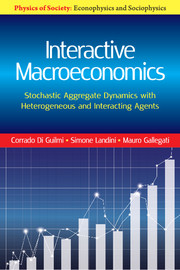Book contents
- Frontmatter
- Dedication
- Contents
- Figures
- Tables
- Preface
- 1 Introduction
- Part I Methodological Notes and Tools
- Part II Applications to HIA Based Models
- Part III Conclusions
- Part IV Appendices and Complements
- Appendix A Complements to Chapter 3
- Appendix B Solving the ME to Solve the ABM
- Appendix C Specifying Transition Rates
- References
- Index
Appendix B - Solving the ME to Solve the ABM
from Part IV - Appendices and Complements
Published online by Cambridge University Press: 23 July 2017
- Frontmatter
- Dedication
- Contents
- Figures
- Tables
- Preface
- 1 Introduction
- Part I Methodological Notes and Tools
- Part II Applications to HIA Based Models
- Part III Conclusions
- Part IV Appendices and Complements
- Appendix A Complements to Chapter 3
- Appendix B Solving the ME to Solve the ABM
- Appendix C Specifying Transition Rates
- References
- Index
Summary
As described in Chapter 3, once the ME is set up, the problem is to find that W (·, t) which satisfies the ME: as noticed, this is not always an easy and feasible task. By further inspection, in the end, the aim of solving the ME is addressed to finding that W (·, t) which allows for inference on dynamic estimators of the expected value and the volatility of the underlying process. Therefore, two ways are open: (a) solve the ME to use it, (b) use the ME without solving it (Section 3.3).
Unless approximation methods are involved, the first way is often unfeasible while the second way provides the needed dynamic estimators of interest, in exact (Section 3.4.2) or mean-field approximated (Section 3.4.3) form. The results obtained in Chapter 3 are specific to the case of jump Markov processes and follow from purely probabilistic reasoning. However, there is no need to assume that the process underlying the ME obeys the Markov property. Moreover, there are methods to deal with analytic inferential modelling even under more sophisticated hypothesis than the simplest nearest-neighbourhood structure.
This appendix gives an interpretation of a well-established method, known as the van Kampen system size expansion, to deal with the second way mentioned earlier in the attempt to provide what is called the solution of an ABM-DGP. Originally, the so-called van Kampen method was developed in the fields of statistical physics and chemistry. However, it can almost easily be presented from a generic mathematical point of view to accommodate for application in other fields. The method requires several calculations, detailed in separate sections to let the interested reader follow all the needed steps. In what follows, the reader is assumed to be familiar with the basics of calculus, mainly computing derivatives, integration and the Taylor theorem.
This appendix provides advanced analytic and methodological insights in the ME approach to solve the ABM-DGP. It can be considered as the description of a methodological technique to deal with the applications developed in Part II of this book. The structure of this appendix is described as follows.
Section B.1 provides a generic description of the discrete ME. Section B.2 presents the ME as an inferential problem about the evolution of the underlying ABM.
- Type
- Chapter
- Information
- Interactive MacroeconomicsStochastic Aggregate Dynamics with Heterogeneous and Interacting Agents, pp. 211 - 241Publisher: Cambridge University PressPrint publication year: 2016



